In some ways, the 1950-51 season was the zenith of Famous Studios existence. Perhaps not creatively, but in their role as Paramount’s in-house cartoon studio they had certainly established a secure position for themselves. Sam Buchwald had not only maintained Popeye’s status as a cartoon superstar, but had successfully introduced a line of cartoon franchises (Baby Huey, Little Audrey, Herman, Buzzy, et al) and was about to launch, as the article from Motion Picture Exhibitor demonstrates below, a new “star” – Casper the Friendly Ghost. Not only had Casper been audience tested, but he would begin a new line of lucrative character merchandising – profits that would go right into the bank account of Famous Studios.
The article below has a few glimpses behind the scenes – Larz Bourne, I. Klein, Winston Sharples are pictured (Kneitel and Sparber get mentioned in the text, as does Alan Shay – the voice of Casper). Can anyone else identify the other artists pictured?

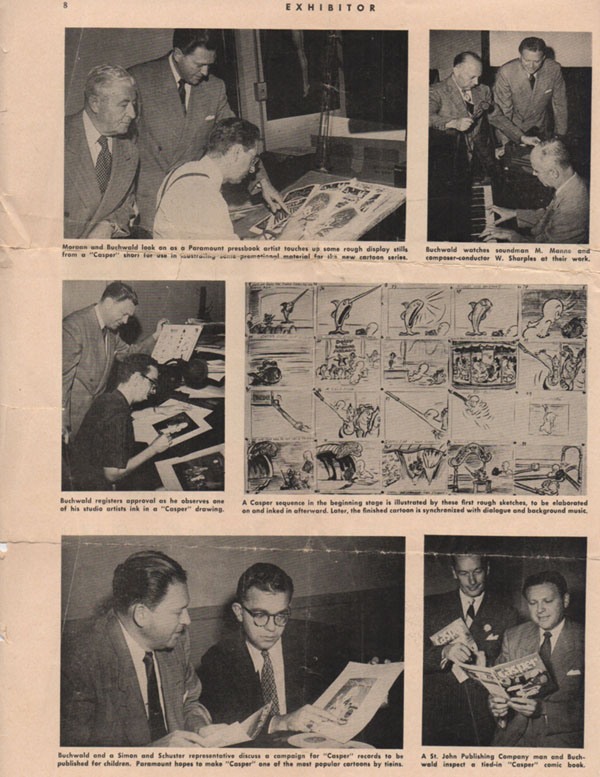
Boxoffice Magazine (clipping bellow) has Popeye in sixth place for 1950 (they note its a drop in popularity from the previous year) – but Famous no longer has any “friendly” competition from Speaking Of Animals (which ran its course) or Pal’s Puppetoons (Pal was by now producing Paramount’s feature When Worlds Collide).
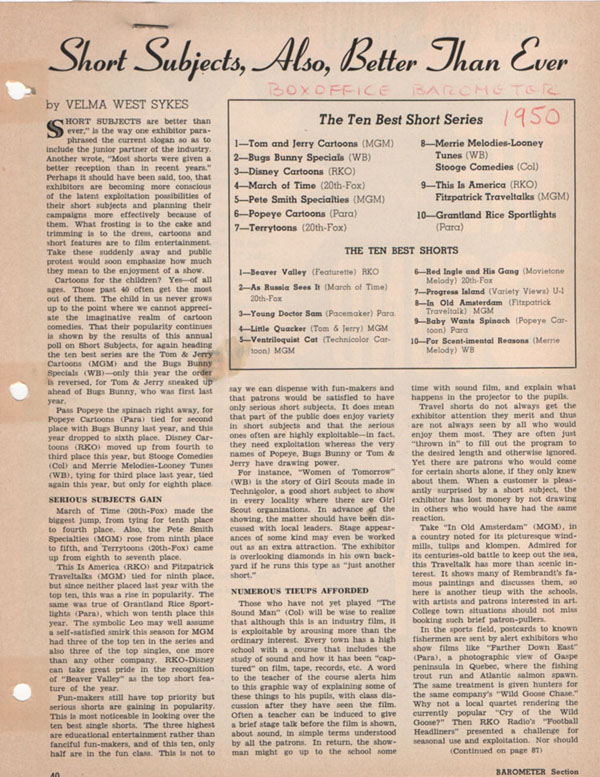
But the high points of the 1950-51 release slate were bittersweet – Sam Buchwald passed away at the end of the season, on August 28th 1951. As we shall see, the studio seemingly “froze” in its tracks without a savvy businessman like Buchwald. Pretty much everything established by now stays on auto-pilot for the next five years (with some exceptions). Let’s take a look at this seasons offerings:
Screen Songs
Fiesta Time
Fresh Yeggs
Tweet Music
Drippy Mississippi
Miners Forty-Niners
Sing Again Of Michigan
The Screen Songs were winding down – but not without a fight. Kneitel/Waldman try spot gags in Mexico, in Mississippi, and in prison. Sparber/Eugster sing along with birds and draw spot gags in Michigan. Sparber/Waldman spoof the gold rush.
Mice Meeting You (Herman & Katnip)
Voice Of The Turkey
Sock-A-Bye Kitty (Buzzy)
One Quack Mind (Baby Huey)
Mice Paradise (Herman & Katnip)
Hold The Lion Please (Little Audrey)
Land Of Lost Watches
As The Crow Lies (Buzzy)
Slip Us Some Redskin
Party Smarty (Baby Huey)
Dave Tendlar’s unit tackles Herman and Katnip in two pictures, Buzzy in two, and Baby Huey in another. Steve Muffatti’s unit draws upon Baby Huey and Little Audrey. Bill Tytla completes his time at Famous with the Thanksgiving one-shot, Voice Of The Turkey; The final Land of the Lost film comes from George Germanetti’s pen; and Dave Tendlar introduces a cute little native American (if one can get past the politically incorrect “Indian” gags) in Slip Us Some Redskin.
Baby Wants Spinach
Quick On The Vigor
Riot In Rhythm
Farmer and The Belle
Vacation With Play
Thrill Of Fair
Alpine For You
Double Cross Country Race
Pilgrim Popeye
Kneitel/Eugster begin the season reviving Sweepea with a remake of Little Swee’Pea (1936). Kneitel/Johnson then remake King Of The Mardi Gras (1935) and Me Musical Nephews (1942), send Olive and Popeye to the farm and on vacation, to a county fair and in a road race. Rounding out the season, Sparber/Muffatti remake I-Ski Love-Ski You-Ski (1936), while Sparber/Eugster crib Tex Avery in a Turkey hunting Pilgrim opus.
One extra note: Howard Beckerman is working at the studio as an assistant at this time – and he’s proudly recalled getting a bonus for suggesting the punny title, “Vacation With Play“. The bonus? An extra $5 in his pay envelope.
Casper’s Spree Under The Sea
Once Upon A Rhyme
Boo-Hoo Baby
To Boo Or Not To Boo
Boo Scout
Casper Comes To Clown
The first of a new series of Casper cartoons – and certainly the most significant and longest lasting original creation the studio ever had. Tytla directed the first. After that, the unit headed by Myron Waldman shared duties with Steve Muffatti this first season – but Waldman’s unit would soon become the Casper specialists. Here, Casper makes friends under the sea, in Mother Goose Land, at the circus, with the Boy Scouts, at an orphanage… and in my favorite, he meets a ghostly girlfriend at a Halloween dance.
BELOW: Here’s the complete storyboard (click each to enlarge) for the first of the official “Casper” series, Casper’s Spree Under The Sea, by Isadore Klein. Then compare it to the finished cartoon, embed at the bottom.

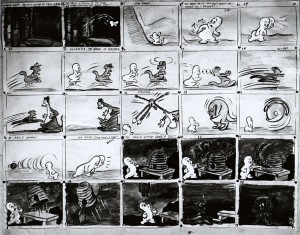
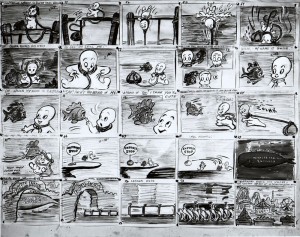
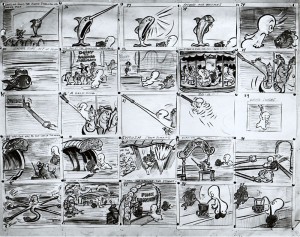
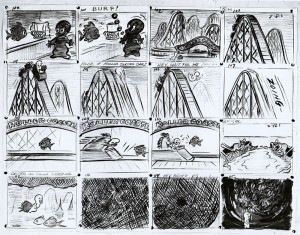

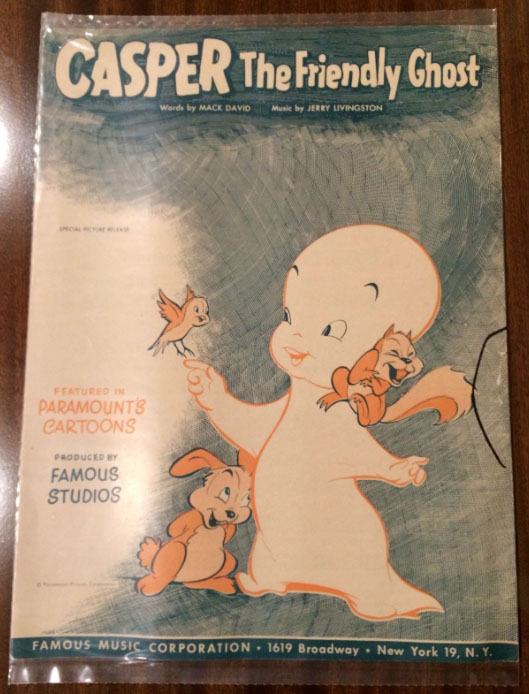
The Casper theme was a huge success for Famous Music
Next Week: Kartunes, Katnip and Life without Sam – 1951-52


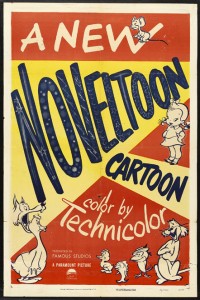

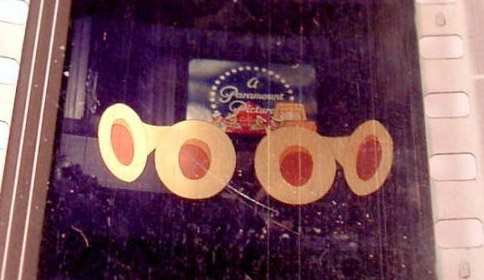
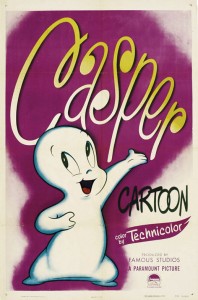
 Jerry Beck is a writer, animation producer, college professor and author of more than 15 books on animation history. He is a former studio exec with Nickelodeon Movies and Disney, and has written for The Hollywood Reporter and Variety. He has curated cartoons for DVD and Blu-ray compilations and has lent his expertise to dozens of bonus documentaries and audio commentaries on such. Beck is currently on the faculty of CalArts in Valencia, UCLA in Westwood and Woodbury University in Burbank – teaching animation history. More about Jerry Beck [
Jerry Beck is a writer, animation producer, college professor and author of more than 15 books on animation history. He is a former studio exec with Nickelodeon Movies and Disney, and has written for The Hollywood Reporter and Variety. He has curated cartoons for DVD and Blu-ray compilations and has lent his expertise to dozens of bonus documentaries and audio commentaries on such. Beck is currently on the faculty of CalArts in Valencia, UCLA in Westwood and Woodbury University in Burbank – teaching animation history. More about Jerry Beck [



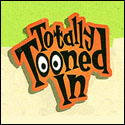



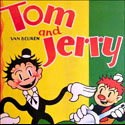
One of the frustrating things about the 1950s at Famous is if they had only been as diverse in the early 1950s with the stories on their continuing series as they were in the latter half of the decade, the series themselves would probably have better reputations today.
That’s especially true in the Casper series, though obviously some of the late-50s stories spin off what had been done in the Casper comic books earlier in the decade — you couldn’t do cartoons with Spooky, Wendy or the Ghostly Trio until Spooky, Wendy and the Ghostly Trio were themselves created. But it would have been fun to see those characters in use before Paramount’s animation budgets were cut to the bone.
The Famous characters soon became the staples of the Harvey universe. As a kid I was perplexed by the corporate title Harvey Famous Cartoons because it seemed redundant (weren’t the Harvey characters already famous?). Now that I know about the history of Famous Studios and their evolution out of the Fleischer Studios, it’s fascinating to see how all of this links together.
In the comic books, Baby Huey had several titles running, as did Casper and Little Audrey. Buzzy and Herman & Katnip were backup features in the Baby Huey comics. My favorite Harvey comic book was “TV Casper and Company” which contained stories featuring Casper as well as Baby Huey, Buzzy, and H & K. The characters only interacted on the cover and in an introductory gag page in each issue, then were in separate stories for the rest of the book. It would have been nice to see some crossovers within the actual stories themselves, but I don’t recall that ever happening.
Another interesting link is the song “It’s a Hap Hap Happy Day” which was used in a number of the Famous cartoons. I guess since they owned the Fleischer rights they had the song under copyright and could use it frequently. I used to wonder how Casper and Popeye both happened to know the same song, because it turned up in each of their respective cartoons.
Sometimes wonder why “Hap-Hap-Happy Day” was used so heavily, but nothing else from “Gulliver’s Travels” was ever recycled (except in the spinoff shorts). And none of the catchy toons from “Mr. Bug Goes to Town” appears to have had an afterlife.
From what I understand, the bulk of the “Gulliver” songs were written by Paramount composers Leo Robin and Ralph Rainger (who also wrote “Thanks for the Memory” and “Love in Bloom,” which became the theme songs of Bob Hope and Jack Benny respectively), but “Hap-Hap-Happy Day” was composed by Winston Sharples.
“We’re All Together Now” was used in “Onion Pacific”.
Baby Want Spinach was the first “look” on the “new Swee’pea” in his (UGH) new two tone pink outfit with a baby bonnet instead his usual outfit with a sailor’s hat ( luckily the comic strip and comic book versions of Popeye still had Swee’pea wearing the same classic outfit that he wore for years instead of that (to my opinion) abomination of a pink outfit that he wore.
Pilgrim Popeye was one of my favorites in which Popeye’s nephews wanted turkey for Thanksgiving dinner but Popeye intervenes his nephew’s plan by telling them a story when he was a Pilgrim and how he spared a turkey’s life and in return how the pilgrim saved Popeye from “savage injuns” or hostile Indians.
What’s weird is that I seen the LATAM (Latin American) Spanish version of Pilgrim Popeye and Popeye claimed that he was a “Boy Scout” instead of saying “Peregrino” which is the correct way to say Pilgrim in Spanish.
Also the 1950’s Casper cartoons shows a “new look” Casper as a slimmer looking ghost instead of the obese little ghost that was first seen in The Friendly Ghost and There’s Good Boos Tonight (even though in my opinion he still acted as a whiny crybaby but outgrow that stage by the mid 1950’s). And in Boo Scout was the first to show a new character named Billy Brown who was a little boy around five to six years old who Casper befriends and helps out.
Were they making Traveltalks as late as 1950? I don’t know that I’ve seen one beyond just after the War.
Were they making Traveltalks as late as 1950?
MGM released the Fitzpatrick Traveltalks into 1954. Paramount released another handful in 1954-55 as “VistaVision Vistas.”
I continue to find these season-by-season looks at Famous interesting
“Hold the Lion Please” is one of my favorite Little Audrey cartoons, though the large part played in it by the family’s stereotypical African American maid has sidelined it in recent years. I find Audrey a more appealing character when her cartoons veer away from the “Audrey has a dream and learns a lesson” formula the series inherited from Little Lulu.
“Double Cross Country Race” was the Popeye that attempted to introduce a new villain to the series, wasn’t it? Count Noah Count. An interesting new bad guy might have given the series a shot in the arm, but the Count wasn’t going to be that villain, since he was pretty much just Bluto with a different face and an accented voice.
I was never fond of the Buzzy cartoons when I was a kid. Maybe I was a hyper-sensitive youngster, but it was a little difficult for me to sympathize with Buzzy when Katnip was already suffering from a killer toothache or whatever. The toothache would be bad enough, but on top of that, the poor dope has a sadistic crow trying to kill him. Now, if Buzzy had cured Katnip’s malady, and the cat had still been determined to make lunch out of him, I would have been entirely in his corner.
Katnip always seemed a little too stupid to be a really effective villain. Tom wasn’t the brightest cat in the universe, but he was capable of posing a real threat to Jerry at times. Katnip was just an idiot, too easily fooled and out-witted. That neither Buzzy nor Herman was particularly cute or endearing didn’t help either series. Neither did the inability of Famous to ever really figure out how to make cartoon violence funny. The violent gags in Famous cartoons are no worse than what Warner and MGM were doing. Famous’s violent gags were always too heavy in execution and too literal in pacing, though. The sheer outrageousness and over-the-top nature of the violence in Warner and MGM cartoons tended to take the “hurt” out of the gags. They were more about the bad guy’s humiliation than about his pain. Famous never got that. The violence in their cartoons just tends to make you wince a little.
Paramount owned its own music publishing division — Famous Music — and Famous wound up with publishing rights to the GULLIVER and MR. BUG songs. Famous Music-owned tunes tended to be the popular songs of choice that turned up in Famous cartoons, though Winston Sharples never seemed to rely on pop songs for his soundtracks to the degree that Carl Stalling did at Warner and Scott Bradley at MGM. I suspect Sharples just liked “It’s a Hap-Hap-Happy Day.”
Famous catches a lot of flack for the repetitive nature of its cartoons, and I’m certainly not going to argue the point or defend the practice. Any of us who grew up watching these on TV knew that the Famous series cartoons were rarely going to differ that much from one another. At the same time, that was much less of an issue back when these films were being made and audiences were catching them only sporadically as filler between feature films. Reminds me of an interview I once read with Bill Gaines, about his horror comics from the 1950s (TALES FROM THE CRYPT, etc.) The person conducting the interview brought up the subject of the sometimes repetitive nature of the stories in Gaines’ comics. For example, the number of stories they did that involved the rotted, decaying corpse of a murder victim returning to mete out justice to the unfortunate killer. Gaines readily admitted to the repetition, but did point out that these comic books were supposed to be read one issue at a time, every two or three months. Not one after another, all in one weekend.
A couple of things occured to me after watching the Casper cartoon posted. First, why is he committing suicide when he’s already dead? Or does he not realize that he’s dead? Also, it’s odd that he seems to be strangled by the rope, especially when he’s already underwater. Finally, I wonder Pixar was inspired by this cartoon when they came up with the ending of Finding Nemo.